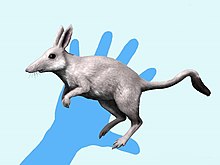Polydolopimorphia
| Polydolopimorphia Temporal range:
| |
|---|---|

| |
| Argyrolagus palmeri | |
| Scientific classification | |
| Domain: | Eukaryota |
| Kingdom: | Animalia |
| Phylum: | Chordata |
| Class: | Mammalia |
| Clade: | Metatheria |
| Clade: | Marsupialiformes |
| Order: | †Polydolopimorphia Archer, 1984 |
| Subgroups | |
Polydolopimorphia is an extinct order of metatherians, closely related to extant marsupials. Known from the Paleocene-Pliocene of South America and the Eocene of Antarctica, they were a diverse group during the Paleogene, filling many niches, before declining and becoming extinct at the end of the Neogene.[1] It is divided into two suborders, Bonapartheriiformes, and Polydolopiformes [2] Most members are only known from jaw fragments, which have their characteristically generally bunodont teeth.[3] The morphology of their teeth has led to proposals that polydolopimorphians may be crown group marsupials, nested within Australidelphia,[4] though this proposal, has been questioned, with other analyses finding them outside of crown-group Marsupialia.[3] The monophyly of the group has been questioned, due to the possibility of the characteristic bunodont teeth emerging convergently in unrelated groups, rather than reflecting a true phylogenetic relationship.[5] The group contained omnivorous, frugivorous and herbivorous forms.[4]
Taxonomy
[edit]Taxonomical subdivision of the Polydolopimorphia:[6]
- Suborder Bonapartheriiformes
- Family Bonapartheriidae Pascual 1980
- Genus Bonapartherium Pascual 1980
- Genus Epidolops Paula Couto 1952
- Family Argyrolagidae Ameghino 1904
- Genus Anargyrolagus Carlini et al. 2007
- Genus Argyrolagus Ameghino 1904
- Genus Hondalagus Villarroel & Marshall 1988
- Genus Klohnia Flynn & Wyss 1999
- Genus Microtragulus Ameghino 1904
- Genus Proargyrolagus Wolff 1984
- Subfamily Chulpasiinae Sigé et al. 2009
- Genus Chulpasia Crochet & Sigé 1993
- Genus Thylacotinga Archer et al. 1993
- Family Prepidolopidae Pascual 1980
- Genus Incadolops Goin & Candela 2004
- Genus Perrodelphys Goin et al. 1999
- Genus Punadolops Goin et al. 1998
- Family Rosendolopidae Goin et al. 2010
- Genus Hondonadia Goin & Candela 1998
- Genus Rosendolops Goin & Candela 1996
- Family Bonapartheriidae Pascual 1980
- Suborder Polydolopiformes
- Family Polydolopidae Ameghino 1897[7]
- Genus Amphidolops Ameghino 1902
- Genus Antarctodolops Woodburne & Zinsmeister 1984
- Genus Archaeodolops Ameghino 1903
- Genus Hypodolops Chornogubsky 2020
- Genus Kramadolops Goin et al. 2010
- Genus Pliodolops Ameghino 1902
- Genus Polydolops Ameghino 1897
- Genus Pseudolops Ameghino 1902
- Family Sillustaniidae Crochet & Sigé 1996
- Genus Sillustania Crochet & Sigé 1996
- Genus Roberthoffstetteria Marshall et al. 1983
- Family Polydolopidae Ameghino 1897[7]
- incertae sedis
- Genus Prepidolops Pascual 1980
- Genus Wamradolops Goin & Candela 2004
- Genus Bobbschaefferia Paula Couto 1970
References
[edit]- ^ Beck, Robin M. D. (2016). "The Skull of Epidolops ameghinoi from the Early Eocene Itaboraí Fauna, Southeastern Brazil, and the Affinities of the Extinct Marsupialiform Order Polydolopimorphia". Journal of Mammalian Evolution. 24 (4): 373–414. doi:10.1007/s10914-016-9357-6. ISSN 1064-7554. PMC 5684316. PMID 29187780.
- ^ Chornogubsky, Laura; Goin, Francisco J. (2015). "A review of the molar morphology and phylogenetic affinities of Sillustania quechuense(Metatheria, Polydolopimorphia, Sillustaniidae), from the early Paleogene of Laguna Umayo, southeastern Peru". Journal of Vertebrate Paleontology. 35 (6): e983238. doi:10.1080/02724634.2015.983238. hdl:11336/46844. ISSN 0272-4634. S2CID 86106580.
- ^ a b Beck, Robin M. D. (2023), Cáceres, Nilton C.; Dickman, Christopher R. (eds.), "Diversity and Phylogeny of Marsupials and Their Stem Relatives (Metatheria)", American and Australasian Marsupials, Cham: Springer International Publishing, pp. 1–66, doi:10.1007/978-3-030-88800-8_35-1, ISBN 978-3-030-88800-8, retrieved 2023-05-14
- ^ a b Goin, Francisco J.; Woodburne, Michael O.; Zimicz, Ana Natalia; Martin, Gabriel M.; Chornogubsky, Laura (2016), "Phylogeny and Diversity of South American Metatherians", A Brief History of South American Metatherians, Dordrecht: Springer Netherlands, pp. 155–183, doi:10.1007/978-94-017-7420-8_5, ISBN 978-94-017-7418-5, retrieved 2022-02-19
- ^ Beck, Robin M. D. (2023), Cáceres, Nilton C.; Dickman, Christopher R. (eds.), "Diversity and Phylogeny of Marsupials and Their Stem Relatives (Metatheria)", American and Australasian Marsupials, Cham: Springer International Publishing, pp. 1–66, doi:10.1007/978-3-030-88800-8_35-1, ISBN 978-3-030-88800-8, retrieved 2024-04-16
- ^ Polydolopimorphia at Fossilworks.org
- ^ Laura Chornogubsky (2021). "Interrelationships of Polydolopidae (Mammalia: Marsupialia) from South America and Antarctica". Zoological Journal of the Linnean Society. 192 (4): 1195–1236. doi:10.1093/zoolinnean/zlaa143. hdl:11336/131166. Along with:
- Enrico de Lazaro: [http://www.sci-news.com/paleontology/polydolopid-marsupials-09287.html Three New Species of Extinct Marsupials Identified, sci-news, Jan 26, 2021




